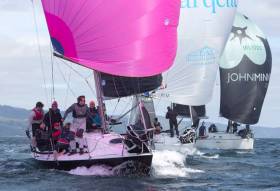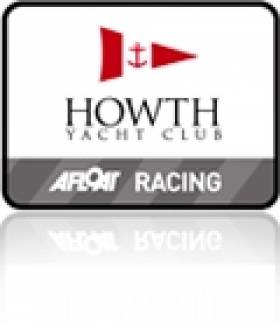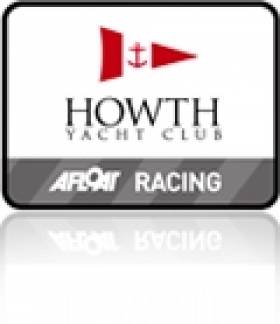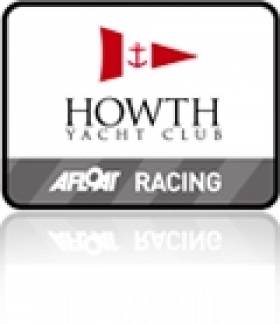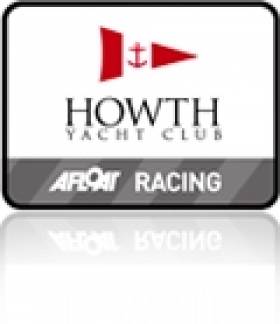Displaying items by tag: Lambay
It’s party time afloat and ashore this weekend at Howth Yacht Club, with the two-day Lambay Regatta – sponsored by Provident – featuring the historic Lambay Race itself on Saturday, while Sunday continues with a Family Day and Fun Race.
The race round Lambay Island – with an extended course for larger craft – dates back to 1904 or even earlier, and is one of the premier annual fixtures in the Howth programme. With a fleet including everything from the 1898-founded Howth 17s (which continue to restore and even increase their numbers after shore-stored boats were damaged in Storm Emma in March 2018) right across the board to hotshot offshore racers recently returned from success in the Scottish Series, the theme is diversity afloat.
And there’s diversity ashore too. The party mood actually starts to build on Friday night, and the weekend programme of barbecues, dinners, and entertainment continues with the Donal Kirk Band providing the highlight on Saturday night, while the family-themed Sunday programme is then rounded out with a Bank Holiday Monday brunch which will be available from 10.0am to 4.0pm.
One of the significant factors in Howth Yacht Club becoming the Mitsubishi Motors “Sailing Club of the Year 2019” is the high value the club puts on environmental awareness through its “Green Agenda”, which was launched last year with the Club’s inauguration of the biennia Wave Regatta. This theme will continue – if anything with added emphasis – through the sport and socialising of Howth Lambay Regatta 2019.
With just three days to the start of the ICRA National Championships, Saturday's annual Lambay Race at Howth Yacht Club on the same race track provided a last minute form guide. Current forecasts reveal a similar sub ten–knot wind for Friday's first day of the national cruiser championships.
Selected Lambay Race results are downloadable below.
The Lambay Race forecast was for a veering wind out of the NNE at approximately eight knots, but going into the east during the day. The start was held just north of Ireland's Eye which meant a beat against a strong ebb tide in order to round Lambay to starboard. The race was decided on the basis on whether you went for the slacker tide on the Portmarnock shore or if you tacked after the start and hope that the wind veered and favoured the boats that went right.
In the end, the shore won out and big gains went to those that got to the beach first. In a nine boat class one, the fleet split with Paul O'Higgins new JPK 10.80 Rockabill VI, and Conor Fogerty's Bam heading right while Storm went to the shore. Storm rounded Lambay first and held that position through the later part of the race. Generally, the remainder of the race was uneventful and the gains on the first beat were all important to give Storm the handicap win.
In the biggest cruiser class, a 15-boat class two, again it was those that got to the shore had the advantage. A further tactical call was whether to continue up the Portmarnock shore out of the tide and ensure you made the island, or tack onto port earlier against the tide and bet that the wind held enough to get you around. Both options in the end worked out. Stephen Quinn's J/97 Lambay rules took the inshore course. Of those that tacked earlier, Mike and Ritchie Evans Half–Tonner Big Picture, with Cork Olympic helmsman Mark Mansfield on board gained from the early tack to lead the four competing Half Tonners around. At this stage Lambay Rules was leading on corrected time. Over the next two hours however, Big Picture broke away from the other half tonners and started to grind down the time gap to be just behind at the last weather mark with a 30–minute run to the finish remaining. By the line the time difference had contracted further. Lambay Rules made steady progress to take the gun but Big Picture did enough to win on corrected time by two minutes. Dave Cullen's Checkmate took third overall.
It is likely that the four half tonners, the J/97 of Stephen Quinn and the X–332, Equinox of Ross McDonald will be the main contenders in Friday's ICRA championships in Class two. Equinox was sailing in class one in the Lambay race where she finished third.
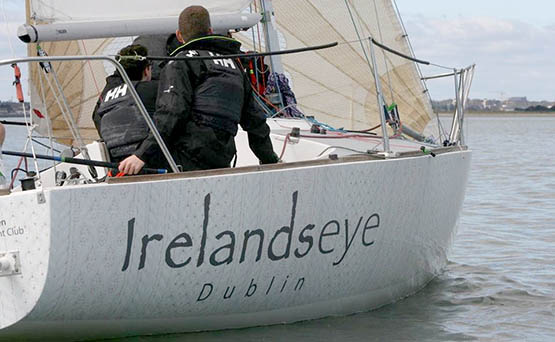
Howth's own K25 crew were Lambay Race winners in class three
In a nine–boat class three fleet, the dominance of Howth's own K25 team in the J/24 Kilcullen continues. Flor O'Driscoll's Hard on Port was second with Vincent Gaffney's Alliance II third.
With light winds forecasted for ICRAs, in class zero it should favour Conor Phelan's Jump Juice who is normally very potent in those conditions.
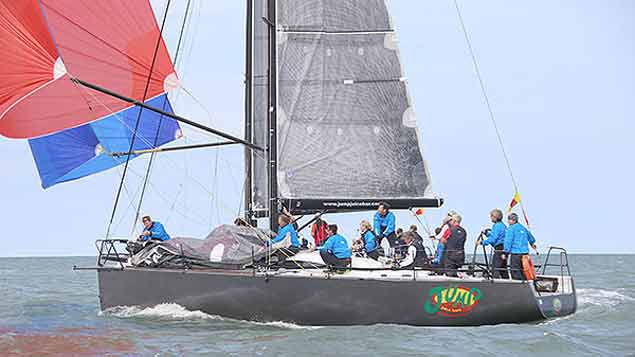
Jump Juice – a light wind contender in class zero

Rockabill VI from the Royal Irish Yacht Club – this JPK 10.80 yacht has an international track record when the breeze is on
In class 1, if it stays light the J109's will be potent. Defending Champion Joker 2 with Mansfield calling the shots, will likely be prominent as will Tim Goodbody's White Mischief, Kelly family's Storm from Howth and John Hall's Something else from Dun Laoghaire. If the breeze comes in and stays in then Paul O'Higgins Rockabill VI will be a favourite to take the win.
In class 2 in light airs, then one of the half tonners should have the edge. Both Checkmate and Big Picture will be without their normal tacticians who are both sailing in class 1. If the breeze comes in Equinox will be hard to beat, as was the case last year in Kinsale.
In Class 3 it will be more open but in the expected light winds the J24's and well sailed quarter tonners will be hard to beat.
Read also: ICRA Nats In Howth Yacht Club Will Attract The Cream Of The Fleets
At Last! June 6th – A Clear Day For Howth's Lambay Yacht Race
#hyc – The 2015 sailing of Howth Yacht Club's one-hundred-and-eleven-year-old annual Lambay Race will see a new major sponsor in the form of Davy Stockbrokers. And for the first time in many years, its date of Saturday 6th June has no fixtures clash with any other major event on the East Coast of Ireland, in the Irish Sea, or with the biennial Dun Laoghaire to Dingle Race, which doesn't start until Friday June 12th.
It is expected that last year's good turnout will be comfortably exceeded, and boat numbers will be further increased by the inclusion of enhanced classes for Old Gaffers and Classics. Like the famous jackyard-topsail-rigged 117-year-old Howth Seventeen Foot One Design Class, the Old Gaffers and the Classics will sail the traditional direct course with a pier start and leaving Lambay to port. But the racing classes will have committee boat starts and take in additional marks while still going round the lovely island which continues to have one of the most unspoilt coastlines in all Ireland.
Howth Yacht Club's Lambay Race Spreads its Historic Net
#lambayrace – Howth Yacht Club's annual Lambay Race has developed over the years into the premier sailing celebration of the coast of Fingal writes W M Nixon. Indeed, there are few places in Ireland which can offer such a beautifully straightforward course of sufficient length to make it something of significance, yet without being unduly long. And the fact that the turning mark of Lambay is an island of such unspoilt natural beauty when so much of the East Coast has been over-developed is a bonus, as is the fact that the course is well clear of all commercial shipping.
It was 1970 when I first sailed the Lambay aboard the late Johnny Pearson's 8 Metre Cruiser/Racer Orana. We must have had a reasonably good race without actually winning, for my abiding memory is of the charm and fascination of the course, and the sense of a large fleet having a good time together in a race well worth sailing.
In those days, the course was simply round Lambay and back to the pierhead line in Howth, though whether you left Lambay to port or starboard would be decided on the day by the Race Officer. But this was a relatively new twist to the event - the traditional Lambay course was through the Sound inside Ireland's Eye, Lambay left to port, then finish back through the Sound.
By the 1980s we were racing our own family cruiser, the Hustler 30 Turtle, and the course was becoming a bit more complex with extra marks in order to ensure there'd be a real beat to suit the new type of hyper-efficient racing yachts. Despite that, we managed in 1981 to get so lucky with our tactics and sail decisions in a varying sou'westerly that little Turtle somehow won overall. But that's not something I'd recommend. It resulted in an ECHO handicap so punitive that in order to get any meaningful racing over the next few years, we had to go to the expense of getting the boat rated under Channel Handicap, which cost a fortune when we didn't have a bean.
Since then, the Lambay course seems to have become ever more complex, so in recent years there has been a certain nostalgia for the straightforward circuit of the old days. The earliest records are sketchy, for all we definitely know is that Howth SC member Henry Stokes put up a cup for a race round Lambay in 1899, yet it doesn't seem to have been raced for until maybe 1902, but it certainly was annually raced by 1904.
However, the best account we have of the Lambay Race in the old days is of the race of 1921, and if you happen to have a copy of A Centenary of Sailing, the history of Howth Yacht Club published for the club's hundredth anniversary in 1995, in it you'll find a vivid account of the race of 1921, written by Pat Walsh of the Royal Irish Yacht Club in Dun Laoghaire. He came second in the cruiser class in a breezy race, sailing single-handed in his lovely little 1905-built 25ft gaff yawl Sheila, which is still in existence.
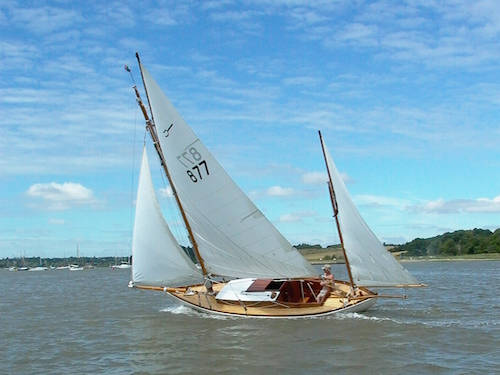
Sheila, the 25ft classic yawl which came second in the Lambay Race of 1921. She has been immaculately restored and maintained in the same ownership in Suffolk for 38 years, and is currently for sale.
The winner of the cruisers in 1921 was designer/builder John B Kearney, a member of Howth SC though he was Ringsend-based in those days. His boat was Ainmara, a 36ft 1912-built 9-ton yawl which, like Sheila, is still going strong. In fact, of the fourteen or so boats which raced round Lambay in 1921, at least ten are still very much in existence, as of course many of the boats which did the race in 1921 were Howth Seventeens.
So for years some of us have had the dream of a sort of a re-enactment of the 1921 race. But the actual movement towards doing something positive came from a different direction entirely. Last year, Howth Seventeen senior skipper Bryan Lynch and his daughter Harriet were asked if they'd like anything special arranged for their boat Echo's Centenary, and one of the good ideas which came up was a special course for the Howth Seventeens in the Lambay Race, though all that was special about it was that it was a welcome reversion to the traditional course.

Bryan & Harriette Lynch's Howth 17 'Echo' taking part in the Old Gaffers Golden Jubilee in Dublin Bay in 2013. It was their request for the revival of the original Lambay Race course to mark Echo's Centenary in 2014 which has resulted in this year's expansion of the traditional element in the Lambay Race on June 6th. Photo: Dave Owens
The idea rang a bell in other quarters, and when it was realized that the morning of the Lambay Race would see the Starter's Hut on the East Pier being manned just to send the Seventeens off on the time-honoured course direct round Lambay, a suggestion for an additional start ten minutes later for Old Gaffers and Classics was readily met.
However, it was well into the season when all this was arranged, but even with the very short notice, four old gaffers turned up to race the course, and had themselves a fine old time. The winner was the Old Gaffers Association International President Sean Walsh with his Heard 28 Tir na nOg, which is now Dun Laoghaire-based, but was of course for many years an adornment of Howth under the ownership of the late Gerry McAvoy, while second place went to the splendid big Galway Hooker Naomh Cronan, which was built sixteen years ago in a community project in Clondalkin, and is still going strong.
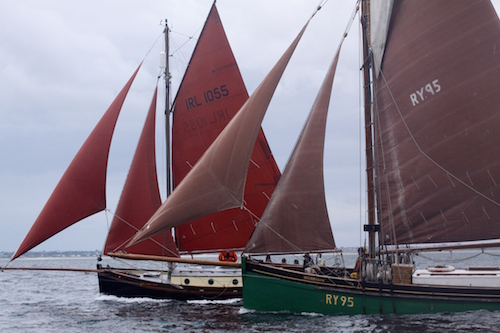
Sean Walsh’s Heard 28 Tir na nOg (left) won last year’s inaugural Lambay Classic. She is seen here with Joe Pennington’s restored Manx Longliner Master Frank, which is a possible entrant for this year’s race. Photo: Dave Owens
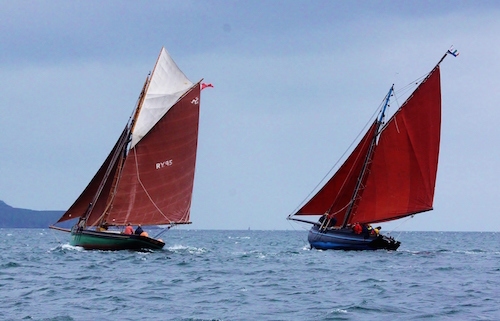
Master Frank (left) and the Galway Hooker Naomh Cronan, which was second in last year’s inaugural Lambay Classic.
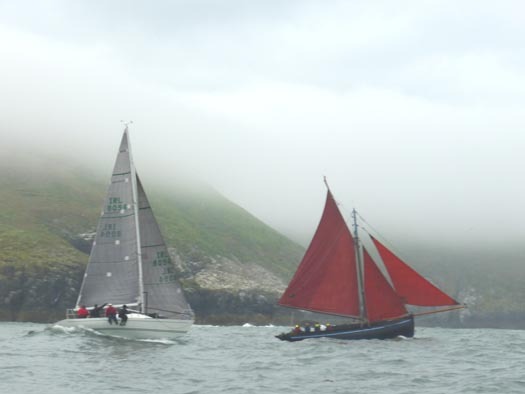
During last year’s Lambay Race, old gaffers like 'Naomh Cronan' made for a marked contrast with racing machines like Dave Cullen’s King One, but despite the large fleet there was room for everyone…… Photo: W M Nixon

…and Naomh Cronan, in company here with two Puppeteers, found the north coast of Lambay to be reminiscent of Connemara. Photo: W M Nixon
This involvement of the Old Gaffers in the Lambay Race of 2014 was an unofficial late addition to their annual programme. But for this year, Lambay Race Chairman James Markey first confirmed that the Seventeens wanted to do the traditional course again, and then sent the Dublin Bay Old Gaffers Association a slightly more formal invitation to take part, and they have accepted.
Already this special "show within a show" of the Old Gaffers in the Lambay is gaining traction. Although the 1921 winner Ainmara is now bermuda-rigged, she's regarded as an Honorary Old Gaffer, and noted offshore racing skipper Dickie Gomes, her owner since 1966, has indicated his intention of coming south from Strangford Lough to race round Lambay on June 6th.
Defending champion Sean Walsh is very much lined up to go again with Tir na nOg, as too is Niamh Cronan from Poolbeg. And a particularly interesting entrant which has been Poolbeg-based this past winter while her owner, Darryl Hughes, lived aboard and studied English-Irish literature in Trinity College, is the magnificently restored 43ft Tyrrell-built 1937 ketch Maybird, which was berthed in Howth for some weeks in 2012.
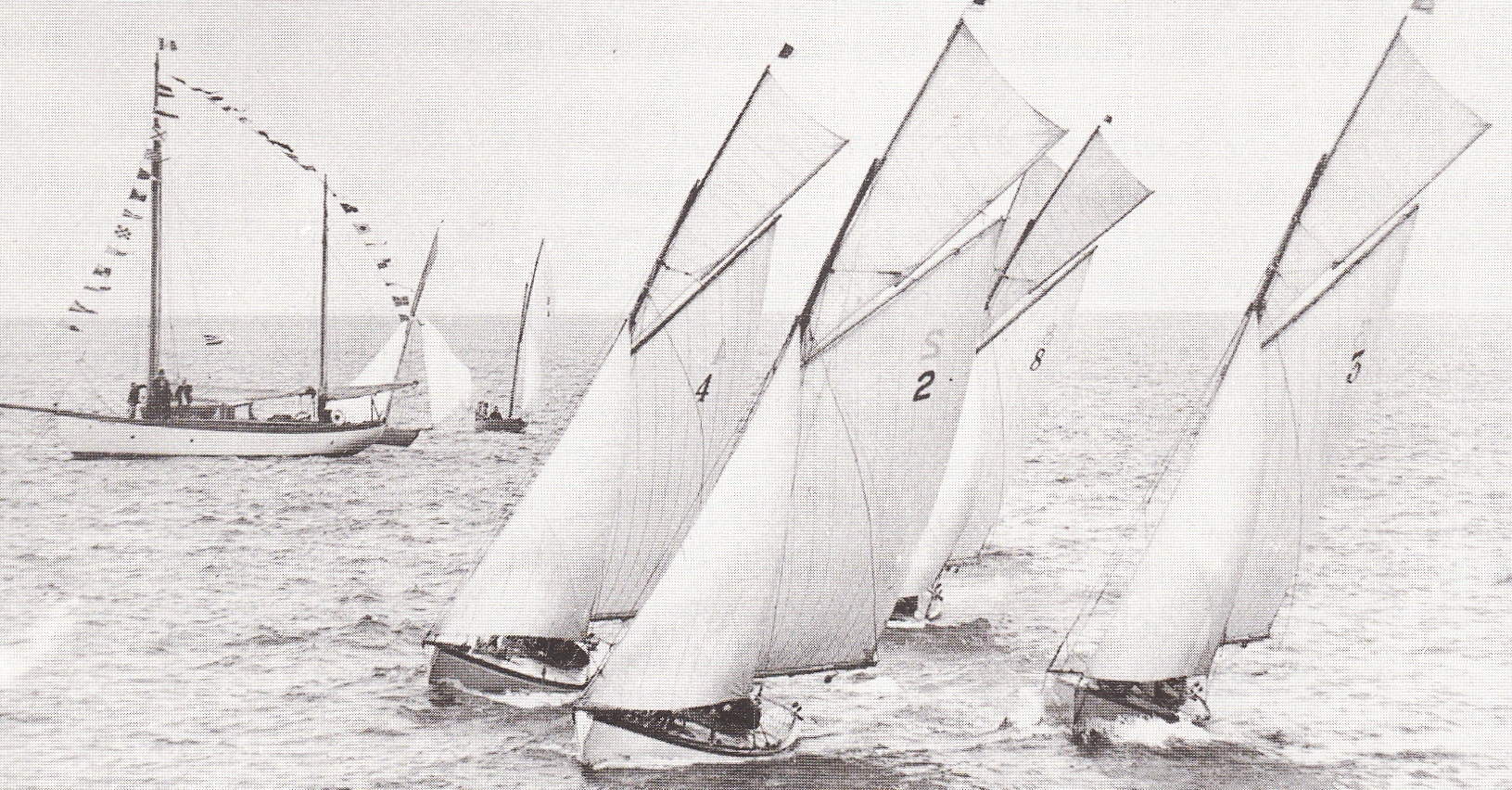
Billy Mooney’s Aideen doing duty as the Committee Boat at Howth Regatta in 1935.
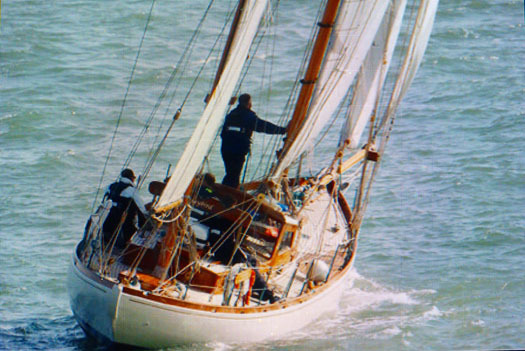
Maybird, the sister-ship of Aideen, has already reserved her marina berth to race round Lambay on June 6th, and her crew will include Paddy Cronin whose father Tom was a regular crewmember on Aideen.
Maybird made a point of visiting Howth during a round Ireland cruise three years ago because she is a sister-ship of the legendary Billy Mooney's 1934-built ketch Aideen, which was Howth-based between 1934 and 1943, and would have done the Lambay Race several times. In Aideen's regular crew in the old days was Tom Cronin, so most appropriately Tom's son Paddy – formerly ace owner-skipper of the Howth 17 Gladys - has signed on to do the Lambay Classic aboard Maybird.
A boat which definitely did the race of 1921 is the 25ft cutter
Marguerite, designed by Herbert Boyd and built by Jack Wellington in 1896 in Malahide, and as she is now owned by DBOGA President Tim Magennis and based in Dun Laoghaire she's very much expected. And so too is longtime Dun Laoghaire gaff rig enthusiast Dennis Aylmer (RIYC), who these days sails the very manageable Cornish Crabber Mona, but back in the 1960s as a very young enthusiast he played a pioneering role in the traditional boat movement by keeping a genuine Galway Hooker in commission in Dun Laoghaire.
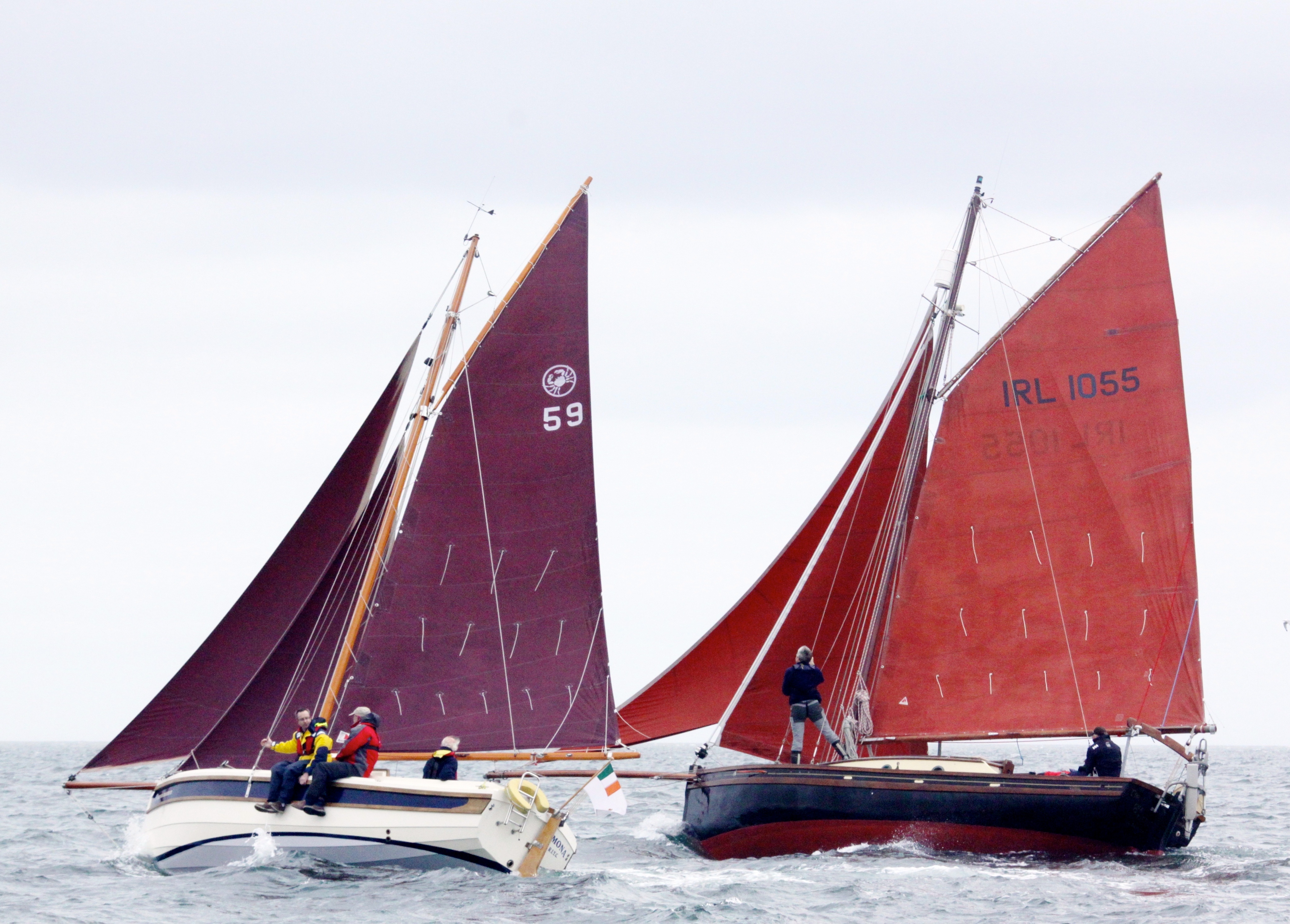
Dennis Aylmer’s Mona (left) with Sean Walsh’s Tir na nOg. Photo: Dave Owens
One of the Irish Sea's most interesting traditional gaffers, Joe Pennington's 1895-built cutter Master Frank from the Isle of Man, will also be taking part if her intrepid owner-skipper can fit the race in around plans to cruise to Brittany. Master Frank really is the business, a fine restoration of the last surviving Manx Longliner, and she is of such significance that she will feature on an Isle of Man postage stamp next month.
So it looks as though the Classic Lambay on June 6th will serve up some varied and colourful participation with the Old Gaffers, and the concept seems to have such appeal that the organisers are also receptive to the idea of giving a third starting signal from the pier to send off a class for those vintage Bermuda-rigged cruisers whose racing days are long past, but whose owners would jump at the chance to take part in the great Lambay sailing festival.
In the midst of all this excited anticipation, is there anyone out there who might be interested in getting the perfect little classic Sheila - second in 1921 - involved again? Despite her Irish Sea background of being built in the Isle of Man in 1905, and based in Dun Laoghaire from 1909 to 1922, Sheila has for the past 38 years been far away in Suffolk, where she has been lovingly maintained and restored by Mike Burn.
But now, after 38 years, he has other things in mind, so if Sheila can find a good home, she'll be sold for 18,000 sterling, which seems to me to be very reasonable value when you remember a new Shannon One Design or Water Wag could cost more. Yet Sheila is of such a handy size that she could conveniently be road-trailed to events like this year's big one, the Glandore Classics Regatta from July 18th to 24th. That is, of course, after coming to Howth and giving Ainmara a tough time in the Lambay Classic Race 2015........
Howth Yacht Club Double-Handed Yacht Race Challenge to Feature Kish, Rockabill & Lambay
#hyc – Howth Yacht Club will run an open double-handed race on Saturday, August 23, 2014 for both spinnaker cruiser classes and white sail cruiser classes. The course will use the Kish Lighthouse, Rockabill lighthouse and Lambay and will start and finish at Howth's East pier. The course will be approximately 40 miles with a start time of 10am and hopeful finish time of late afternoon.
Double handed sailing is the fastest growing fleet within the RORC race calendar and so this challenge will give a taste of shorthanded sailing to HYC crews and hopefully will attract visitors from other local clubs.
Preparation and participation in the HYC Double handed Challenge is a great way for competitors to build shorthanded sailing skills and have a safe fun passage.
So put this in your diary, pick a crew (just one) and go for a practice sail. Entry forms, Notice of Race and Sailing Instructions will be posted soon.
Lambay Race Win for 'Bite the Bullet' off Howth
#lambay – Howth Yacht Club's 2014 Lambay Races were supported by a keen fleet of almost 120 boats, from the modern day stripped-out racers to equally spartan machines of 1898 writes Emmet Dalton. The Howth 17 Footer and Old Gaffer fleets avoided the nasty, modern business of a beat to a windward mark and started a half hour earlier from Howth's East Pier and made directly for Lambay. Selected results available to download below.
Meanwhile, their younger brethern, forever spending money trying to go faster, spent additional time sailing in the wrong direction from inshore and offshore start lines towards windward marks before deciding to turn towards the target.
Exotic materials are never a guarantee of success as the "Back" of Lambay snorted its usual laugh at the leaders. Skippers who bit off five metres too much or little towards the crags were rewarded with nothing more than gull droppings on their decks or inadequately muffled slagging from their faster moving neighbours.
The early part of the day didn't hold out much promise of the golden orb breaking through but as the race progressed and the rounding of a fog-cloaked Lambay was completed, there was enough sun to allow the salt to caulk on the faces of those closer to the front of boats.
This term's Top Boy was Colm Birmingham and his chums who took "Bite the Bullet" on a faster field trip than the other classes, bagging the (Anatomically perfect) Lambay Lady.
From our 17 Footer reporter, Mary Faherty:
Rita took the lead at the start. However Ian Malcolm's Aura overtook her just past Claremont Beach followed closely by Oona. Then the whole fleet disappeared into the heavy fog. Lambay was no where in sight and everyone was guessing compass bearings. When the sun finally broke through the fleet was just to the east of Lambay, again with Rita just in the lead. She held her position and rounded Lambay in first and finished a whooping 4 minutes ahead of the next boat. Oona and Aura raced for second place on the water. Hugh Walsh who had taken Sheila for the race and walked away with the handicap prize
Details from the Puppeteer 22 Class Captain, Cabbage Kavanagh:
In the Puppeteers the 14 boat fleet started with a short beat, rounded the windward and headed into the mist in search of the eastern end of Lambay. As always the racing was tight. After exchanging the lead several times, Eclipse slipped ahead of Blue Velvet behind the island and held on to take the BP/Teeling trophy on scratch, with Harlequin in 3rd and Odyssey squeezing in 4th, showing good speed on one of their first outings of the season. In the handicap division experience told with Cloud 9, rumoured to have competed in every Lambay race since 1906, taking the John Pearson cup, ahead of Schiggy in 2nd, Enigma in 3rd, doing well on their first attempt at Lambay, and Geppetto in 4th.
Strengthen Fingal's Freedom for the Good of Irish Sailing
#fingal – The Government's recent move to create a framework for the direct election of a new all-powerful Mayor for Dublin was expected to be a shoo-in. The new Super-Mayor's authority would incorporate the current four local councils of Dun Laoghaire-Rathdown, South Dublin, Dublin City, and Fingal, each one of which had to vote in favour. But Fingal's councillors voted firmly against it, despite emphatic support of the proposal by the councillors in the other three areas. As a Fingallion by adoption, W M Nixon strongly supports this independent move by a largely rural and coastal region which has a longer shoreline than all the other Dublin areas put together, and is clearly not a naturally integral part of the city.
Fingal is the Ukraine of Leinster, and the glowering monster of Dublin is the Russia within Ireland, intent on the conquest of its smaller freedom-seeking neighbour. Vigorous, all-powerful, intensely urban, and distinctly impressed with itself, Dublin is certain that the further its bounds are spread, the better it will be for all its citizens. And the more citizens it can claim, then the better for Dublin.
But Fingal is different. For sure, it can seem a bit sleepy and rural by comparison with central Dublin, but that's the way we like it. It's a place of odd little ports and much fishing, a region of offshore islands, rocky coasts and many beaches on one side, and the profound heart of the fertile country on the other. A place where – as you move north within it - you might make a living in many ways at once, taking in growing vegetables, raising animals, running a dairy herd, and keeping a lobster boat down at the local quay, while perhaps having a horse or two as well. And if you feel like more shore sport, the golfing options are truly world class.
As for the sailing and all other forms of recreational boating, Fingal is not just a place of remarkable variety – it's a universe. With five islands – six if you count Rockabill – its 88 kilometre coastline is one for sport, relaxation and exploration. Sea angling is well up the agenda, and it's a kayakers' paradise, while Irish speed records in sailboarding and kite-surfing have been established in the natural sand-girt canal which forms for much of the tidal cycle in the outer Baldoyle estuary immediately west of Howth.
Apart from fishing boats – and inshore they're usually only the smaller ones – it has no commercial traffic. And though there are tidal streams, in southern Fingal's main racing area between Ireland's Eye and Lambay, they're not excessively strong, and run in a reasonably clear-defined way, while the flukey winds which so often bedevil Dublin Bay away to the south are much less of a problem in sailing off Fingal, where the winds blow free.
The range of boat and sailing clubs of Fingal matches the variety of its coast. The most southerly is Sutton Dinghy Club, rare among Ireland's yacht clubs in being south-facing. It may be focused on sailing in Dublin Bay, but scratch any SDC sailor, and you'll find a Fingallion. Round the corner of the Baily – not a headland to be trifled with - Howth has two clubs, the yacht club with its own marina, and Cumann na Bhad Binn Eadair (the Howth Sailing & Boat Club) in the northeast corner of the harbour, while Howth Sea Angling Club with its large premises on the West Pier is one of the tops in the country.

The sunny south. Sutton Dinghy Club is Fingal's most southerly sailing club, and is also rare in Ireland through being south facing.
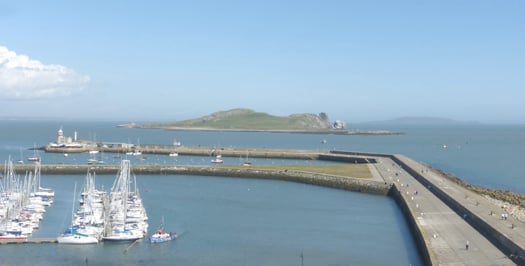
Islands of Fingal seen across the eastern part of Howth marina, with Ireland's Eye in the foreground, and Lambay beyond. Photo: W M Nixon
As for the waters they share, their most immediate neighbour is the steep island of Ireland's Eye with its pleasant southwest-facing beach, the island itself a remarkable wild nesting site, particularly when you remember that it's close beside an intensely urban setting. When a discerning visitor described Ireland's Eye as "an astonishing and perfect miniature St Kilda", he wasn't exaggerating.
Across in Malahide, where we find Fingal's other marina, Malahide YC - which recently celebrated its Golden Jubilee and currently has Graham Smith as its first second-generation Commodore – is in the curious position of having two clubhouses. One is a charming and hospitable place among trees within easy stroll of the marina, while the other is west of the long railway embankment which retains the extensive inner waters of Broadmeadow. This makes the waters into a marvellous recreational amenity and boating and sailing nursery, so not surprisingly it is home to active sailing schools. And it is also the base of Malahide YC "west", a dinghy sailing club on the Broadmeadow shore at Yellow Walls, while further west of it again is yet another club, the more recently formed Swords Sailing & Boating Club.

The map of modern Fingal shows how the southwest corner of the present region seems remote from the largely coastal and rural nature of much of the rest of the county. And it also confirms the surprise (to many) that the Phoenix Park is in Fingal.
North from Malahide, and you're into "Fingal profonde", its deeply rural nature occasionally emphasised by the sea nearby. The long Rogerstown Estuary, the next inlet after Malahide, sometimes found itself providing the northern boundary of The Pale, and as recently as the early 1800s the river at Rogerstown and the tiny port of Rush were a veritable nest of smugglers, privateers and occasionally pirates, with buccaneering captains of myth and legend such as Luke Ryan and James Mathews proving to have been real people who were pillars of society when back home in their secretive little communities after their lengthy business forays to God know where.

Muddy situation. Low water in the Rogerstown Estuary. The hill in the distance on the left is new – for years, it was the largest dump in Ireland, the Balleally Landfill. But now it is well on its way to rehabilitation as an enhancement of the landscape. Photo: W M Nixon
The Rogerstown Estuary went through an unpleasant period when its inner waters were dominated by the nearby presence of the biggest waste dump in Dublin, Balleally Landfill. It rose and rose, but now it's closed, and is in process of being revived to some sort of natural state. The result is that the vista westward from Rogerstown is much improved by a pleasant and completely new hill which so enhances the view at sunset that shrewd locals have built themselves a row of fine new houses facing west, along the quirkily named Spout Lane which runs inland from the estuary.
Whatever about the legality-pushing privateer skippers who used Rogerstown Estuary as their base in days of yore, these days it's home to the quay and storehouse which serves the ferry to Lambay, which is Fingal's only inhabited island when there are no bird wardens resident on Rockabill, and it's also the setting for another south-facing club, Rush SC. It is spiritual home these days to the historic 17ft Mermaid Class (they still occasionally build new ones in an old mill nearby), but despite the very strong tidal streams where the estuary narrows as it meets the sea, RSC also has a large cruiser fleet whose moorings are so tide-rode that unless there's a boat on the buoy, it tends to disappear under water in the final urge of the flood. This can make things distinctly interesting for strangers arriving in and hoping to borrow a mooring while avoiding getting fouled in those moorings already submerged. Not surprisingly, with their boat sizes becoming larger like everywhere else, Rush SC find that their bigger cruisers use Malahide Marina.
To seaward of Rogerstown, with the little port of Rush just round the corner, the view is dominated by Lambay. A fine big island with is own little "miniature Dun Laoghaire" to provide a harbour on its west side, it has a notable Lutyens house set among the trees. But for many years now Lambay has been a major Nature Reserve, so landing is banned, though anchorage is available in its three or four bays provided you don't interfere with the wildlife along the shore. This makes it off bounds to kayakers who might hope for a leg stretch on land, though it's still well worth paddling round close inshore.
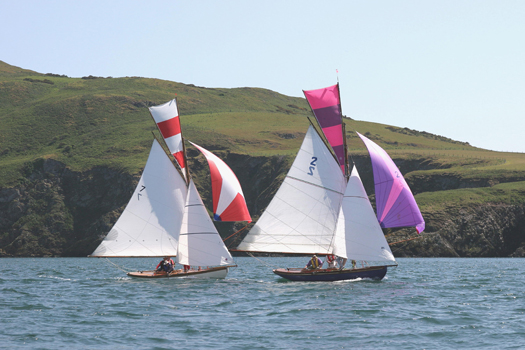
Racing round Lambay. Close competition between the Howth 17s Aura (left) and Pauline, which have been racing annually round Lambay since 1904. Photo: John Deane
Along the Fingal mainland coast, the next inlet after Rush is Loughshinny, a lovely natural harbour with a quay to further improve the bay's shelter. There's a very active little fishing fleet, while the shoreside architecture is, how shall we say, decidedly eclectic and individualistic? Go there and you'll see what I mean.
Six miles offshore, Rockabill marks the northeast limits of Fingal. It's a fine big double-rock, with a substantial lighthouse and characterful keepers' houses attached. But as it's now automated, the only time Rockabill is inhabited is for the four summer months when a bird warden or two take up residence to monitor the rocky island's most distinguished summer residents, Europe's largest breeding colony of roseate terns.
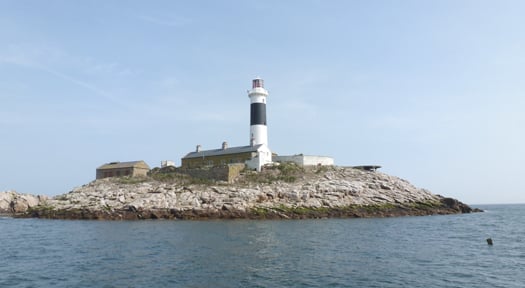
Rockabill, where the shy roseate terns feel at home. Photo: W M Nixon
In Fingal we tend to take these pretty but noisy summer visitors for granted, but the word is that south of Dublin Bay the tern buffs are so incensed by Rockabill having a clear run that they're tried to start a rival colony of roseate terns on the Muglins, and built a row of tern houses (one good tern deserves another) to facilitate their residence. The potential nest sites may not have survived the past severe winter. But in any case, one wonders if they had planning permission from Dun Laoghaire/Rathdown council for this development? Persons suggesting that such a development would almost certainly be terned down will not be given any attention whatsoever.
Skerries and Balbriggan are the two main sea towns of north Fingal, and they're as different as can be, the difference being emphasised by historic rivalry. It's said that back in the government harbour-building days of the late 19th Century a grant was made available to assist local landowners to make significant improvements to one of the harbours, and this meant war.

Balbriggan may very definitely dry out, but it provides a secure home port for both trawlers and other boats prepared to settle on the mud and sand. Photo: W M Nixon
So eventually the grant was split with half going to improve Balbriggan, and the other half to Skerries, with neither being a total success. If you seek total shelter in either today, you have to be prepared to dry out, while the anchorage off Skerries is also subject to a large tidal whorl which means that when the ebb is running in a strong onshore wind, the moorings are doubly rough and diabolically uncomfortable. And every so often after an exceptional nor'easter, we have another litany of boats driven ashore and Skerries yacht insurance going even further through the roof.
It's a situation which needs proper attention from an administration which is genuinely interested in the port. And the proper development of the harbour at Skerries, while retaining the little old place's special character, is surely something which could be much better done by Fingal Council rather than some remote Mayor of Dublin for whom Skerries will be the outermost periphery, a place seldom visited, if at all.
We've seen it all before. Time was when Fingal was simply the North County, little noticed in the centres of power which were basically Dublin City and Dublin County, their head offices in the heart of the city. But then in 2001 the new four-council setup was created, and the old name of Fingal – never forgotten by those who cherished the area – was revived. A very fine new user-friendly County Hall – it has even been praised by Frank McDonald of The Irish Times – was built in the re-born county town of Swords. Out on the new boundaries meanwhile, the signs went up saying "Welcome to Fingal County". But we old Fingallion fogeys pointed out that as Fingal means "Territory of the Fair Strangers" (i.e the Norsemen rather than the Danes), it was superfluous to be describing it as "the county of the territory", so these days it's just Fingal, and we're happy with that.
Here in Howth, we sort of slipped into acceptance of the new setup. Once upon a time, from 1917 to 1943, Howth had its own Urban District Council. It says much for the place's remoteness from the world that the HUDC was established in the midst of one global war, and quietly wound up in the midst of another. In 1943, Commissioners had to be imposed on the tiny fiefdom to offset the fact that some local interests thought the HUDC existed entirely for their own personal benefit. So at various times since, Howth was run either by Dublin County Council, or even by Dublin City Corporation. We were assured that this latter setup was all to our benefit, as the powers-that-be in City Hall had a soft spot for Howth, sure wasn't it the place where the mammy went every Thursday evening to buy the family's fish, and wouldn't she want to see it looking well?
Maybe so, but when it came to doing something more useful with the harbour, Howth Yacht Club – having re-constituted itself in 1968 from an amalgamation of Howth Sailing Club (founded 1895) and Howth Motor Yacht Club (founded 1934) - found itself dealing with a bewildering variety of government departments as the lowly interests of fishing and its ports seemed to be shifted whenever possible by civil servants who reckoned that banging the drum on behalf of fisheries in particular, and maritime interests in general, was not a shrewd career move for anyone planning a steady progress up the very landbound Irish public service ladder to the sunlit uplands of a long and prosperous retirement.
So if at times absolutely nothing seemed to be happening in a harbour which was painfully inadequate for expanding boating and fishing needs, it was partly because the club officers and fishermen's leaders could find it difficult to discern just who in authority could or would make the decisive call. In those days it turned out to be somewhere in the hidden recesses of the Office of Public Works. Suddenly, in 1979, a plan for the major re-development of the harbour was promulgated at official level, with a radical rationalisation planned for its future use. The western part, it was proposed, would become totally fisheries, while the eastern part was to be given over to recreational boating, all of it involving major civil engineering and harbour works projects.
Looking at the successful harbour today, it all seems perfectly reasonable and sensible. But back in 1979 when HYC were presented with a time-limited take-it-or-leave-it choice, the way ahead was not at all clear. Friendships were sundered and family feuds emerged from the heated progress towards accepting the offer that the club agree to vacate its premises on the West Pier - a clubhouse which it had renovated and extended only ten years earlier – and commit itself to the installation, at members' cost, of a marina in the eastern harbour with the obligation to build a completely new clubhouse there.

Today's Howth Harbour didn't happen overnight. This is how it was from 1982 until the new clubhouse was completed in 1987. Photo: W M Nixon
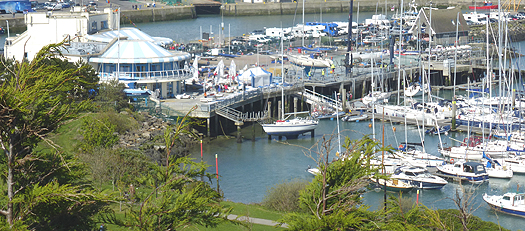
Multiple activities under way at Howth YC this week. The club's setup may seem only natural now, but it was quite a struggle to get there. Photo: W M Nixon
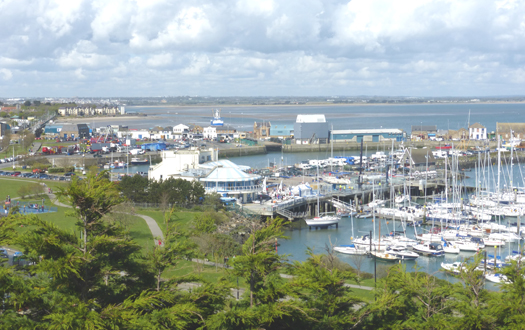
Howth's vibrant mix of a working fishing port and busy sailing centre has provided the ideal setting for the development of a successful visitor and seafood destination. Photo: W M Nixon
It's all history now, but it was done. And done so well by those involved that today it's simply taken for granted. Arguably, it's a compliment to those who created the Howth YC setup, that newer members should seldom wonder how it all came to happen, it just seems so right and natural. And as for those running the club, they in turn have to build on past achievements in dealing with an ever-changing administrative environment in which the changeover to being part of Fingal was only one of several evolutions.
Yet the recent attempt to abolish Fingal was a wake-up call. In Howth we may have wandered into it, but in just a dozen years, a dormant Fingal identity has come quietly but strongly awake. In Howth village it's natural enough, as our backs are turned to Dublin and we look to the rest of Fingal. But even on the south side of the hill, where fine houses face across Dublin Bay and you'd expect a sense of identity with households in similarly choice locations for all that they look north out of Dun Laoghaire, you find that the attraction of visiting the southside has the exotic appeal of going foreign, while those of us more humbly placed in the village, if visiting remote places like Rathmines or Terenure, find it positively unnerving to think of all the houses between us and the sea.
Then too, while Fingal Council has been establishing itself in our hearts and minds, it has been a good time for Howth Harbour. Good fences have been making good neighbours, and though marine administration in government has been kicked from pillar to post, an underlying Department of Fisheries recognition that their harbours cannot be only about fishing has led to a re-think on the use of buildings about the harbour, with Howth becoming an extraordinary nexus of good seafood restaurants, such that on a summer evening, despite the presence of a traditional fish and chip shop, the seafood aroma is of a proper fishing port in Brittany or Galicia. In fact, rents from the hospitality and sailing and marine industries in Howth have now reached such a level that fish landing fees – formerly the bedrock of the harbour economy – only contribute about 10% of the overall income.

The man from County Hall. Fingal Mayor Kieran Dennison is comfortable with his county's busy sailing activities, and the sailors are comfortable with him. He is seen here officially opening the J/24 Worlds at Howth in August 2013. Photo: W M Nixon
As for how we've been getting on with our new masters in County Hall up in Swords, the news is good. Most recently, we've been having direct contact with the current Mayor of Fingal, Kieran Dennison, who hit just the right note when he officially opened the J/24 Worlds in Howth in August 2013. Following that, he was back at the annual Commodore's Lunch in HYC in the dark days of November when a review of the past season lightens the onset of winter, and he was able to tell us that thanks to contacts made at the Worlds, his invitation to visit the America's Cup in San Francisco in September was made even more enjoyable. Those of us who reckoned the only way to visit the 34th America's Cup was on the television screen were reassured by the thought that if somebody was going to represent us in the San Francisco bear-pit, then our Mayor, our very own Mayor of Fingal, was just the man for the job.
So we very much want to keep Fingal in existence and in robust good health, but we appreciate that its current boundaries might be creating a bit of a Ukraine-versus-Russia situation. In particular, the southwest of the county could well be Fingal's Crimea and Donetsk regions. There, relatively new settlements of ethnic Dubs in places like Clonsilla, Castleknock, Blanchardstown could become such a source of trouble that it might be better to transfer them peacefully to administration by either Dublin city or South Dublin before there is unnecessary bloodshed.
The situation arises because, when the boundaries were being drawn, southwest Fingal was set out all the way down to the Liffey. The Fingallion instinct would be to see the border drawn along the Tolka, in other words the M3. But there could be trouble because of the discovery – always something of a surprise – that the Phoenix Park is in Fingal. I could see that when some people find our Fingal includes the Park, they'll want to fight for it, particularly as, in the southeast of the county, the excellent St Anne's Park in Raheny was somehow allowed to slip into Dublin City.
One thing which is definitely not for transfer is the Airport. It is naturally, utterly and totally part of Fingal. For sure, it contributes a fifth of the county's annual income from business rates, making Fingal the economically healthiest Irish county. But we in Fingal have to live with the airport very much in our midst. If Dublin really wants to take over the airport, then a first condition before negotiations even begin would be that all flight paths are to be re-routed directly over Dun Laoghaire and Dalkey. A few weeks of that would soon soften their cough.
Whatever, the recent kerfuffle about Fingal rejecting involvement in administration by an all-powerful Mayor of Dublin has been a powerful stimulant to thinking about how our own county might best be run. Everyone will have their own pet local projects, and most of us will reckon that decision-making in Swords, rather than in some vast and impenetrable office in the middle of Dublin, will be the best way to bring it about. For those of us who go afloat, the fact that Fingal Council shows that it cherishes its long and varied sea coast, rather than preferring to ignore it, is very encouraging. And the fact that this prospering county has some financial muscle all of its own gives us hope that we can build on what the past has taught us, and spread improved facilities to every port. Should that happen, it will in turn benefit Irish sailing and boating generally to a greater extent than would restricted development under one closely-controlled central administration headed by some southside megalomaniac.
New Video on Howth Yacht Club's 2012 Lambay Race
#lambayrace – Following the success of the First 31.7, Bluefin Two (Bernie Bryson & Mia Delaney) from Dun Laoghaire who won the Lambay Lady a week ago, race sponsors ITC have produced a short five minute video of the 116th edition of the Howth Yacht Club race.
No Way to Treat a Lady
#HYC – When you've been staging a successful sailing race annually since 1899 or thereabouts, it's something which has will have acquired its own momentum with a significant amount of baggage in the nostalgia stakes. And its enduring popularity inevitably means that anyone minded to donate a trophy to the hosting club will want to get aboard the high-flying bandwagon of the big one.
Today's annual ITC Lambay Race at Howth looks to have everything going for it, not least an improvement in the ghastly weather which has dominated this past week. The race's prestige is such that it seems to have accumulated more silverware through its various divisions and classes than any other single race on the east coast – and perhaps the entire country, for that matter.
Taking in courses round the handsome Lambay and its quirky little sister island of Ireland's Eye, the Lambay Race is a celebration of the coast of Fingal which - during the ICRA National Championship a fortnight ago - showed how it can provide good sailing breezes when Dublin Bay is serving up windless frustration.
For this classic, they seem to have found a trophy for just about everything except being dog last, and even that must be only a matter of time. The supreme award is the Lambay Lady (think Little Mermaid of Copenhagen), and it goes to whichever winning boat in any of the myriad classes has the greatest margin ahead of the runner-up.
You might reasonably think this inevitably means whoever wins it sails in the most uneven and uncompetitive class of all, but somehow this never seems to happen, as it all often comes down to split seconds. And as they try to run the prize giving a short time after the very last boat has finished, the calculators are over-heated to come up with a result.
Last year, Dun Laoghaire's Ken Lawless and his team with their very competently up-graded vintage Quarter Tonner Supernova were initially declared the winners. The Lawless crew were well on their way back across Dublin Bay with their boat groaning under a load of silverware when some enthusiast in HYC ran a computer check on all the results and came up with the news that the host club's David Clark with his Puppeteer 22 Harlequin should have been awarded the Lambay Lady.
Dave Clark being the man whose day job is keeping the vintage dishwashers of Howth in working order through these stringent times, this just had to be put right, and Howth YC handled it with some style. They have experience of being on the receiving end of this kind of error. Five years ago, when local boats were scoring big internationally, Howth's Roy Dickson with the Corby 36 Rosie was announced as the initial overall winner of the British IRC Championship in the Solent, a big deal by any standards. The trophy had been back in Howth for 24 hours, and well celebrated, when Royal Ocean Racing Club CEO Eddie Warden-Owen made a sheepish phone call asking for their cup back – Rosie had actually been beaten for first overall by a fraction of a point.
So HYC's Brian Turvey handled the Supernova imbroglio with exemplary diplomacy, offering Ken Lawless dinner for two in Howth YC with all the trimmings if he could just see his way to bringing the Lambay Lady over with him, though of course keeping all the other cups. Today, we'll expect a double run on the results before making the final award. But even then, if you do win the Lambay Lady but subsequently have to give it back again, don't mess about - hold out for free dinner for all the crew.
W M Nixon's sailing column is in the Irish Independent on Saturdays
Electro to Sponsor Howth Yacht Club Lambay Races
The annual Howth Yacht Club Lambay Race - Howth Regatta - is to be called the Electro Lambay Race following confirmation of sponsorship by Electro Automation Group, widely regarded as Ireland's premier automation specialist and an international leader in such areas as automated car park systems, gate and door access control systems, and intelligent transportation systems.
The race takes place on June 12 and online entry is available now. (see below)
Operating from headquarters in Damastown, near Mulhuddart, Electro was established in 1984 and now has operations in Lisburn, Galway, the UK, and Germany. The Electro brand is synonymous with advanced technology and service reliability across a wide range of products that control movements of personnel and vehicles, automatic gates and bollards, doors and barriers, hands-free access control, under-vehicle surveillance and CCTV security.
The Electro sponsorship will include a significant input into the 'family day' theme of this year's sailing which is expected to attract around 140 boats and over 1,000 sailors and visitors.



























